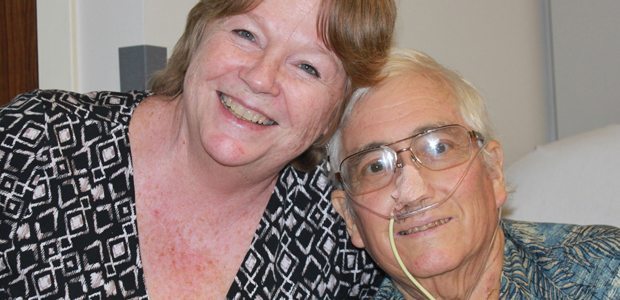University of Arizona surgeons Zain Khalpey, MD, and Robert Poston, MD, became the first to implant a left ventricular assist device using the surgical robot in John Hulslander, 67, who was losing his battle with ischemic cardiomyopathy.
Since the groundbreaking surgery in May, four more patients have undergone the robotic procedure at The University of Arizona Medical Center – University Campus.
“Nobody in the world is doing this and we have done five of them,” said Dr. Khalpey, associate professor in the UA Department of Surgery Division of Cardiothoracic Surgery and surgical director of the Heart Transplant and Mechanical Circulatory Support Program at UAMC. “The patients are all doing smashingly.”
Hulslander and his wife, Ellen, who live in Maricopa, Ariz., said the surgeons and staff at UAMC saved his life. “It was do this or die,” said Hulslander, who is retired from the U.S. Coast Guard and the U.S. Navy.
Hulslander became critically ill in December 2012, and visited the hospital 14 times between then and April 2013. His heart was failing and his kidneys were shutting down. He was so sick, Phoenix doctors would not operate. Instead, they sent him to UAMC in Tucson.
Hulslander needed a ventricular-assist device implanted in his chest to pump blood for his dying heart while he waited for a heart transplant. However, Hulslander’s case was complicated; he had no sternum – a serious infection following quadruple bypass in 1997 resulted in its removal. The pectoralis muscle flap used to repair his infected sternum had become “plastered” to his heart, making any repeat heart surgery nearly impossible and something that most other centers would not attempt.
Often, having to do a reoperation involving the midline chest incision carries a three-fold morbidity and mortality at the time of a transplant, said Dr. Khalpey. Hulslander was a prime candidate for using the surgical robot, which does not require opening the chest.
Without the surgery, Hulslander would not be alive today, said Dr. Khalpey. Along with Dr. Poston, professor of surgery, the surgical team implanted a new-generation, smaller ventricular assist device called the HVAD Pump.
The Da Vinci Surgical Robot was used to implant the pump through small incisions between the ribs. The precise, minimally-invasive procedure preserved his muscle flap for when he will have a heart transplant. Because the sternum was infected from the prior surgery, this approach dramatically reduced the risks of massive blood loss and injury to the heart.
The eight-hour procedure was so successful, the surgeons knew it could save the lives of other end-stage patients. “We decided this was probably the way of doing things so we did the next one four days later,” Dr. Khalpey said.
These patients are doing well and are building their strength before going on a heart transplant list or possibly receiving stem cell treatments to regenerate growth of healthy heart tissue using their own stem cells, a new procedure that Dr. Khalpey is investigating.
The left ventricular assist device that was implanted in Hulslander is powered by a lightweight, highly efficient battery that he wears in a pack around his waist. Patients with the device can leave home for up to six hours, and plug back into a power source at home.
So far, the benefits of using the robot to assist in the procedure seem dramatic, Dr. Poston said. He added that avoiding bleeding and transfusions is a benefit for any patient, but particularly those in need of a heart transplant, minimizing the chance of future organ rejection. Leaving the sternum intact during the device implant can reduce the chance of infection, less pain, speed up recovery, thereby making a heart transplant down the road more likely to be successful.
Hulslander, who said he experienced minimal pain after surgery, was amenable to being the first to undergo the robotic surgery.
“Somebody’s got to be first,” he said as he relaxed in a chair, eating lunch. “I’m feeling pretty good.”
“The UA Department of Surgery continues to be a leader for robot-assisted surgery,” said Rainer W.G. Gruessner, MD, professor and department chairman. “Our surgeons have the expertise to perform procedures rarely offered at other institutions and to use advanced technology that leads to new innovative options for the benefit of our patients.”




